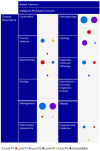Malignant phyllodes tumours of the breast: the case for revising WHO's 'full house' diagnostic criteria
- PMID: 40223225
- PMCID: PMC12232237
- DOI: 10.1111/his.15455
Malignant phyllodes tumours of the breast: the case for revising WHO's 'full house' diagnostic criteria
Abstract
Phyllodes tumours (PTs) of the breast present diagnostic challenges due to their complex histological features and potential for malignant behaviour. The World Health Organisation (WHO) classification requires the presence of five adverse histological criteria to categorise PTs as malignant, aiming to avoid overdiagnosis and improve diagnostic consistency. However, emerging evidence suggests that these strict criteria may underdiagnose tumours with metastatic potential and histological features that would otherwise be considered malignant in soft tissue tumours, leading to significant implications for prognosis and treatment. Recent studies have highlighted cases where tumours classified as borderline PT by WHO criteria exhibited metastatic behaviour, emphasising the need to refine the diagnostic framework. Microscopic criteria used to classify PT also vary among reporting pathologists, resulting in suboptimal reproducibility. This review examines the histological parameters utilised in the classification of malignant PT, highlights existing evidence gaps and analyses international breast pathologist survey data to propose a pragmatic diagnostic approach. We recommend redefining malignant PTs to include cases meeting four of the five WHO criteria, supplemented by comprehensive sampling and clinical context. This approach balances the risk of underdiagnosis with the need for standardised, reproducible diagnostic practices. Future collaborative efforts should focus upon developing evidence-based, biologically relevant classification systems and leveraging technological advancements to enhance diagnostic precision. These efforts aim to refine classification, improve prognostic accuracy and optimise patient management strategies.
Keywords: breast; grade malignancy; phyllodes tumours.
© 2025 The Author(s). Histopathology published by John Wiley & Sons Ltd.
Conflict of interest statement
The authors have no relevant financial or non‐financial interests to disclose.
Figures





References
-
- Lakhani SR, Ellis IO, Schmitt SJ, Tan PH, van de Vijver MJ. WHO classification of tumours of the breast. 4th ed. Lyon: IARC, 2012.
-
- WHO Classification of Tumours Editorial Board . Breast tumours. 5th ed. Lyon: IARC, 2019.
-
- Lyle PL, Bridge JA, Simpson JF, Cates JM, Sanders ME. Liposarcomatous differentiation in malignant phyllodes tumours is unassociated with MDM2 or CDK4 amplification. Histopathology 2016; 68; 1040–1045. - PubMed
-
- Li X, Nguyen TTA, Zhang J et al. Validation study of the newly proposed refined diagnostic criteria for malignant Phyllodes tumor with 136 borderline and malignant Phyllodes tumor cases. Am. J. Surg. Pathol. 2024; 48; 1146–1153. - PubMed
-
- Turashvili G, Ding Q, Liu Y et al. Comprehensive clinical‐pathologic assessment of malignant Phyllodes tumors: Proposing refined diagnostic criteria. Am. J. Surg. Pathol. 2023; 47; 1195–1206. - PubMed
Publication types
MeSH terms
Grants and funding
LinkOut - more resources
Full Text Sources
Medical

